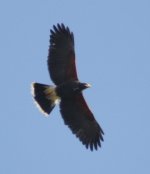ColD
Save the Egyptian Vulture in Greece
Whilst stopping off on the final day of our UK trip, we decided to look into Watlington off junction 6, M40 to watch the Red Kites again.
When we had twenty of these Kites overhead flying with four Common Buzzard and a Sparrowhawk I noticed another darker bird flying high.
It stayed in the vicinity for a couple of minutes before heading northwards.
I suspect a Harris Hawk, its the only bird in any of my books that presents with such a wide black band and trailing white edge on the tail feathers.
The Greater coverts do not seem deep enough.
Has anyone else seen this bird in the vicinity ?
Cheers
ColD
When we had twenty of these Kites overhead flying with four Common Buzzard and a Sparrowhawk I noticed another darker bird flying high.
It stayed in the vicinity for a couple of minutes before heading northwards.
I suspect a Harris Hawk, its the only bird in any of my books that presents with such a wide black band and trailing white edge on the tail feathers.
The Greater coverts do not seem deep enough.
Has anyone else seen this bird in the vicinity ?
Cheers
ColD





